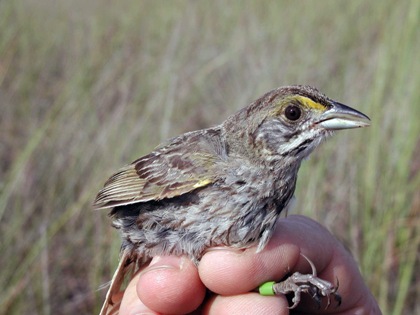|
You are viewing ARCHIVED content published online before January 20, 2025.
Please note that this content is NOT UPDATED, and links may not work. For current information,
visit https://www.nps.gov/aboutus/news/index.htm.

Lori Oberhofer, ENP
Contact: Linda Friar, 305-242-7714 Contact: Dave Hallac, 305-224-4200 Contact: Sonny Bass, 305-242-4200 Superintendent Dan Kimball has announced the results of the Everglades National Park annual Cape Sable Seaside Sparrow survey. The 2007 overall population estimate for this endangered bird showed a small increase over 2006 numbers. The population increase resulted entirely from growth in the largest subpopulation. The other five subpopulations either remained constant or decreased in size (Table 1). Native to south Florida, Cape Sable Seaside Sparrows occur in six separate subpopulations on State and National Park Service lands. In 2007, the total population was estimated to contain 3,184 individuals, a small increase over the 2006 estimate of 3,088, but substantially lower than the 6,600 individuals estimated during the period from 1981-1992. While some variation in population size is normal for this species, the decline that occurred after 1992 is atypical. Subpopulation A, located west of Shark River Slough in Everglades National Park decreased from an estimated 112 birds in 2006 to 64 birds this year. In the past, this subpopulation comprised more than 50% of the total population. Biologists estimated that there were more than 2,600 birds during the period from 1981-1992; however, from 1993-1995, the size of this subpopulation fell dramatically to 240 birds. After 1995, the population increased slightly, but no substantial recovery has been observed. This year’s estimate of 64 birds represents the second lowest estimate on record. Subpopulations B and E are currently the largest, with 2,512 and 560 birds, respectively. The size of subpopulation B, located on the east side of Shark River Slough and south of the main park road, increased from 2,080 individuals last year to 2,512 in 2007. However, subpopulation E had a 20% decrease in numbers from the previous year. Subpopulation C exhibited a 70% decrease in size from last year’s estimate of 160 birds, down now to 48 birds. Prescribed burning activities that were initiated outside and to the east of Everglades National Park are believed to be the likely reason for this decline. In the spring of 2007, a prescribed fire jumped the L-31 North Canal on the park border into the park and burned a large portion of the habitat in this subpopulation. Subpopulations D and F are of particular concern to park biologists. No birds were located in either subpopulation during this year’s routine survey. Three birds were, however, detected in subpopulation D in the course of more intensive follow-up searches. Despite the changes described in some of the subpopulations, the overall status of the sparrow did not change appreciably in 2007. The National Park Service, U.S. Fish and Wildlife Service, and other partners will continue to monitor, study, and provide recommendations to ensure the recovery of this endangered species in its natural habitat. Contact: Sonny Bass or David Hallac (305-224-4200) Table 1. Population estimates for the Cape Sable Seaside Sparrow for 1981 and 1992-2007. Estimates are obtained by multiplying the number of surveyed birds by 16.
NS = Not Surveyed -ENP- | ||||||||||||||||||||||||||||||||||||||||||||||||||||||||||||||||||||||||||||||||||||||||||||||||||||||||||||||||||||||||||||||||||||||||||||||||||||||||||||||||
Last updated: April 14, 2015
